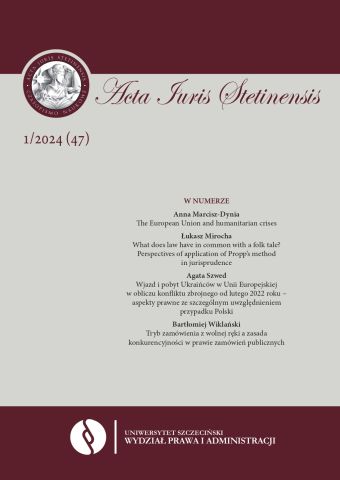






| Authors: |
Paweł
Mańczyk

Uniwersytet Szczeciński Dominika Wróblewska 
Uniwersytet Szczeciński |
| Keywords: | Personal Income Tax tax stimulation of demographic growth |
| Data publikacji całości: | 2024-03 |
| Page range: | 19 (43-61) |
| Downloads ?: | 42 |
| 1. | Balicki J., Uwarunkowania i skutki kryzysu demograficznego w Polsce, „Teologia i Moralność” 2010, nr 7. |
| 2. | Bartosiewicz A., Kubacki R., PIT. Komentarz, Warszawa 2015. |
| 3. | Bartosiewicz A., Kubacki R., Ulga prorodzinna – zeznanie roczne za rok 2009, „Przegląd Podatkowy” 2010, nr 3. |
| 4. | Budlewska R., Ulga na dzieci jako instrument realizacji polityki prorodzinnej w Polsce, „Annales Universitatis Mariae Curie-Skłodowska, sectio H – Oeconomia” 2016, nr 50. |
| 5. | Doroszewski W. (red.), Słownik języka polskiego. Warszawa 1996–1997. |
| 6. | Goettel A., Goettel M., Zmiany prorodzinne w podatku dochodowym od osób fizycznych, „Przegląd Podatkowy” 2009, nr 4. |
| 7. | Janicki T., Ulga prorodzinna jako jeden z instrumentów polityki prorodzinnej państwa, „Przegląd Podatkowy” 2015, nr 12. |
| 8. | Jędrejek G., Komentarz do art. 145, w: G. Jędrejek (red.), Kodeks rodzinny i opiekuńczy. Komentarz aktualizowany, Warszawa 2020. |
| 9. | Kalus S., Komentarz do art. 10, w: Kodeks cywilny. Komentarz. Tom I. Część ogólna (art. 1–125), M. Fras, M. Habdas (red.), Warszawa 2020. |
| 10. | Marciniuk J., Komentarz do art. 27f, w: R. Marciniuk (red.), Podatek dochodowy od osób fizycznych. Komentarz, Warszawa 2017. |
| 11. | Rękas M., Ulga na dzieci jako instrument polityki rodzinnej a niska dzietność w Polsce, „Prace Naukowe Uniwersytetu Ekonomicznego we Wrocławiu” 2016, nr 451. |
| 12. | Sokołowski T., Prawo rodzinne. Zarys wykładu, Poznań 2008. |
| 13. | Szczepańska I., Rozwiązania o charakterze prorodzinnym w polskiej konstrukcji podatku dochodowego od osób fizycznych nieprowadzących działalności gospodarczej, „Ius Novum” 2013, nr 2. |